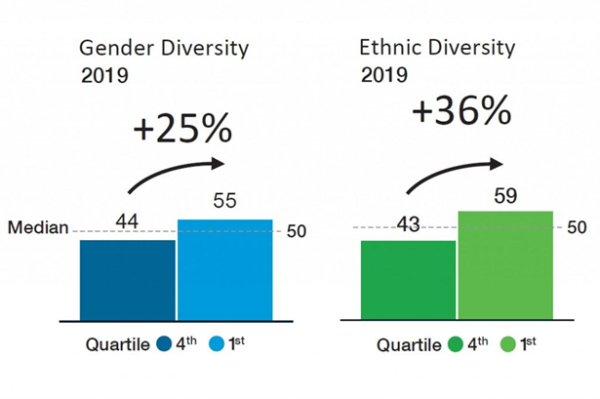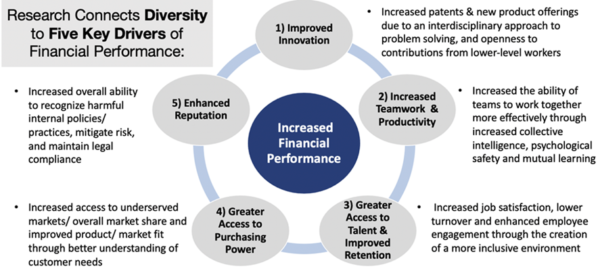
Diversity as a Revenue Engine: What 16+ Studies Reveal
“What’s the business case for DEI?” is one of the most common questions we hear. Investing in diversity, equity and inclusion (DEI) leads to cost savings through reduced attrition and absenteeism, and faster, less expensive recruiting; it also contributes to the top line as well. Dozens of studies from respected sources have revealed the business benefits related to DEI so we’ve compiled 16+ studies that show why DEI is a revenue engine.
- McKinsey’s 2020 report: Diversity Wins: How Inclusion Matters analysts found that, “Companies in the top quartile for gender diversity on their executive teams were 25 percent more likely to experience above-average profitability than companies in the fourth quartile,” as well as “36 percent likelihood of outperformance on EBIT margin for ethnic and cultural diversity.”

- The World Economic Forum’s report Diversity, Equity, and Inclusion 4.0 suggests that companies with diverse employees have “up to 20% higher rate of innovation and 19% higher innovation revenues.”
- A frequently cited study by Catalyst found that Fortune 500 companies with three or more women board directors attained markedly higher financial performance, on average, than those with the lowest representation. Those with the highest percentage of women achieved 53 percent higher return on equity, 42 percent higher return on sales, and 66 percent higher return on invested capital.
- The Center for Talent Innovation found that employees in firms with above average diverse leaders are 60 percent more likely to see their ideas developed, 75 percent more likely to see their innovation implemented, 70 percent more likely to have captured a new market in the past year, and 87 percent more likely to feel welcome and included in their teams.
- According to PwC’s 20th annual CEO survey (2020), diversity and inclusion was the top priority for global CEOs, with 83 percent agreeing that they promote diversity and inclusion initiatives.
- Per the diagram below, the Berkeley University Center for Equity, Gender, and Leadership has found that DEI drives five key levers of financial performance.

Berkeley University Center for Equity, Gender, and Leadership
- The Center for Equity, Gender and Leadership has found that companies with a higher proportion of women in their executive committees possessed stronger financial performance, including a 41% increase in Return on Equity on average, and those in the top 25% for gender diversity are 15% more likely to possess financial returns above national industry means.
- A 2016 Credit Suisse study reported that firms with 25% female senior leadership outperformed peers at a 2.8% compound annual growth rate. This annual growth rate number increased to 4.7% for companies with 33% female senior leadership and 10.3% for companies with 50% female senior leadership.
- A 2018 Harvard Business Review article states that firms in the top quartile for racial and ethnic diversity and inclusion are 35 percent more likely to have financial returns above their respective national industry medians and that diversity overall improved profitable investments at the individual portfolio-company level and overall fund returns. Teams that shared the same ethnicity experienced a lower success rate for investments: 26.4%, compared to 32.2% for diverse teams.
The same article states that firms with above-average DEI measured by six dimensions – migration, industry, career path, gender, education, age – had 9% points higher EBIT margins, on average.
- A HBR article reports that employees of firms with diverse leadership are 45% likelier to report a growth in market share over the previous year and 70% likelier to report that the firm captured a new market. This article also demonstrates that when members of a team have traits in common with a client, such as ethnicity, they are 152% likelier than another team to understand that client, and that leaders who emphasize inclusion, by giving diverse voices equal airtime, are nearly twice as likely as others to unleash value-driving insights, and employees in a “speak up” culture are 3.5 times as likely to contribute their full innovative potential. Where diversity exists without equity and inclusion, these results are rarely achieved.
- A study by the Center for Talent Innovation reports that ideas from women, people of color, LGBTs, and Gen-Ys are less likely to win the endorsement they need to go forward because 56% of leaders don’t value ideas they don’t personally see a need for. The data strongly suggest that homogeneity stifles innovation.
- Leaders should also bear in mind that changing demographics are causing the buying power of people of color to increase much more quickly than that of White Americans and that already a majority of youths under 18 are of color. By 2030 a majority of young workers will be people of color, and by 2040, people of color will be the majority across the US as a whole.
- Bear those numbers in mind when you consider that a recent Glassdoor survey found that 67% of job seekers evaluate a company’s diversity practices before accepting a job offer.
- Moreover, employees with the highest level of engagement perform 20% better and are 87% less likely to leave the organization, according to a survey by Towers Perrin.
- And, according to LinkedIn, turnover costs employers half of an entry-level person’s salary and up to 250% of a senior executive’s salary. As you tap diverse networks for critical talent like data scientists, sales specialists and engineers, imagine the costs of losing and having to replace them, let alone the costs and difficulty of recruiting them if your firm is not already known as a great place for diverse talent to work.
- Performance Excellence Network compiled an up-to-date and compelling list of financial and business reasons for DEI:
- The top quartile of diverse companies are more likely to financially outperform their national industry means – 35% for ethnic diversity and 15% of gender diversity (McKinsey)
- Diverse management teams deliver 19% higher revenues from innovation (defined as new products within three years) compared to their less diverse counterparts; in other words, they produce better ideas (BCG)
- Companies with a diverse workforce enjoy 2.3 times higher cash flow per employee, and smaller companies as much as 13 times higher cash flow (Bersin)
- Employees in highly diverse and inclusive organizations show 26% more team collaboration and 18% more team commitment than those in non-inclusive organizations (CEB/Gartner)
- Teams that follow an inclusive process make decisions two times (2X) faster with half the meetings, and decisions made by diverse teams delivered 60% better results (Forbes)
- Inclusive companies are three times (3X) more likely to retain Millennials for more than five years (Deloitte)
- According to a national study, those who experienced discrimination at work were twice as likely as those who have not to report illness, injury, or assault which impacts productivity, engagement, and overall workforce effectiveness (NCBI)
CHCI weaves over a decade of DEI expertise into all of our core offerings. If you want to determine your company’s DEI strengths, opportunities for growth, and actionable next steps, check out DEI360, our new online assessment tool. We’d love to help.
Recommended Reading
- Laura Tyson, Jeni Klugman, Genevieve Smith, Business Culture & Practice As A Driver For Gender Equality & Women’s Economic Empowerment, org
- Mark Misercola, Higher Returns with Women In Decision-Making Positions, Credit Suisse, March 2016
- Girls Rule, Forbes, October 2010
- Rocio Lorenzo, Martin Reeves, How and Where Diversity Drives Financial Performance, Harvard Business Review, June 2018.
- Paul Gompers, Silpa Kovvali, The Other Diversity Dividend, Harvard Business Review, July/August 2018.
- Vivian Hunt, Dennis Layton, Sara Prince, Why Diversity Matters, McKinsey & Company, 2015
- Why DEI Matters, Catalyst, June 2020
- Rocío Lorenzo, Nicole Voigt, Miki Tsusaka, Matt Krentz, Katie Abouzahr, How Diverse and Inclusive Leadership Teams Boost Innovation, The Boston Consulting Group, June 2018
- Rocío Lorenzo, Nicole Voigt, Karin Schetelig, Annika Zawadzki, Isabell M. Welpe, Prisca Brosi, The Mix That Matters: Innovation Through Diversity, The Boston Consulting Group, April 2017
- Sylvia Ann Hewlett, Melinda Marshall, Laura Sherbin, How Diversity Can Drive Innovation, Harvard Business Review, December 2013
- Mariateresa Torchia, Andrea Calabrò, Michèle Morner, Board of Directors’ Diversity, Creativity, and Cognitive Conflict: The Role of Board Members Interaction, International Studies of Management & Organization, vol. 45, no. 1 (2015): p. 6-24.
- Sylvia Ann Hewlett, Melinda Marshall, Laura Sherbin, and Tara Gonsalves, Innovation, Diversity, and Market Growth, Center for Talent Innovation, 2013
- Muhammad Ali, Isabel Metz, Carol T. Kulik, Retaining a Diverse Workforce: The Impact of Gender-Focused Human Resource Management, Human Resource Management Journal, vol. 25, no. 4 (2015): p. 580-599.
- Dana Kabat-Farr, Lilia M. Cortina, Sex-Based Harassment in Employment: New Insights into Gender and Context, Law and Human Behavior, vol. 38, no. 1 (2014): p. 58-72
- Lindsey Joyce Chamberlain, Martha Crowley, Daniel Tope, Randy Hodson, Sexual Harassment in Organizational Context, Work and Occupations, vol. 35, no. 3 (2008): p. 262-295.
- Cary Funk and Kim Parker, Women in STEM See More Gender Disparities at Work, Especially Those in Computer Jobs, Majority-Male Workplaces, Pew Research Center, January 2018
- Anat Drach-Zahavy, Revital Trogan, Opposites Attract or Attack? The Moderating Role of Diversity Climate in the Team Diversity-Interpersonal Aggression Relationship, Journal of Occupational Health Psychology, vol. 18, no. 4 (2013): p. 449-457.
- Stephan A. Boehm, David J.G. Dwertmann, Florian Kunze, Björn Michaelis, Kizzy M. Parks, Daniel P. McDonald, Expanding Insights on the Diversity Climate-Performance Link: The Role of Workgroup Discrimination and Group Size, Human Resource Management, vol. 53, no. 3 (2014): p. 379-402.
- Stephanie N. Downey, Lisa van der Werff, Kecia M. Thomas, Victoria C. Plaut, The Role of Diversity Practices and Inclusion in Promoting Trust and Employee Engagement, Journal of Applied Social Psychology, vol. 45, no. 1 (2015): p. 35-44.
- Society for Human Resource Management, Employee Job Satisfaction and Engagement: The Doors of Opportunity Are Open: Executive Summary(2017): p. 2.
- Angela Glover Blackwell, Mark Kramer, Lalitha Vaidyanathan, Lakshmi Iyer, Josh Kirschenbaum, The Competitive Advantage of Racial Equity
- Brian S. Lassiter, The ROI of DEI: Still Much Work To Do, Performance Excellence Network, March 2021
- Ronadso Hardey, The Role of DEI. Credit Union Times, Credit Union Times, March 2020
Let’s share experiences. Leave a comment below, send me an email, or find me on Twitter.

